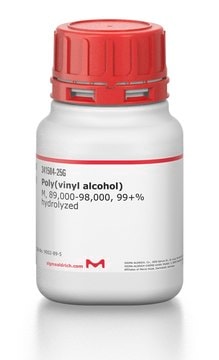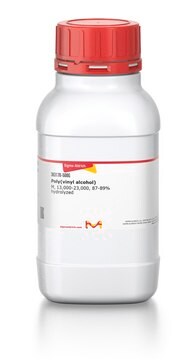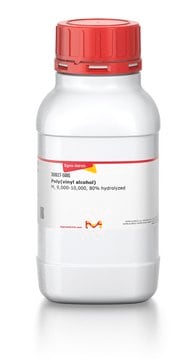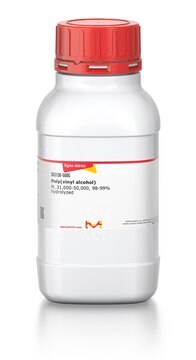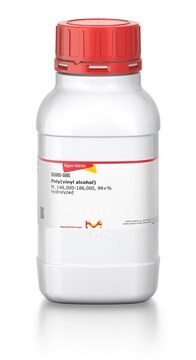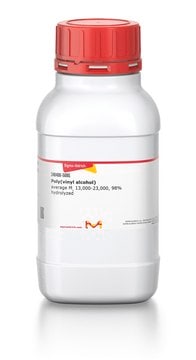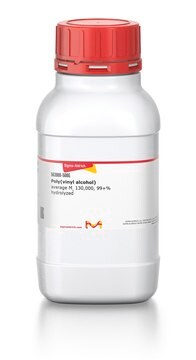If this product has an expiration or retest date, it will be shown on the Certificate of Analysis (COA, CofA). If there is no retest or expiration date listed on the product's COA, we do not have suitable stability data to determine a shelf life. For these products, the only date on the COA will be the release date; a retest, expiration, or use-by-date will not be displayed.
For all products, we recommend handling per defined conditions as printed in our product literature and website product descriptions. We recommend that products should be routinely inspected by customers to ensure they perform as expected.
For products without retest or expiration dates, our standard warranty of 1 year from the date of shipment is applicable.
For more information, please refer to the Product Dating Information document: https://www.sigmaaldrich.com/deepweb/assets/sigmaaldrich/marketing/global/documents/449/386/product-dating-information-mk.pdf
P8136
Poly(vinyl alcohol)
87-90% hydrolyzed, average mol wt 30,000-70,000
Synonym(s):
PVA, PVAl, PVOH, Poly(Ethenol)
About This Item
Recommended Products
Quality Level
form
powder
mol wt
average mol wt 30,000-70,000
viscosity
4-6 cP, 4 % in H2O(20 °C)(lit.)
solubility
H2O: soluble
InChI
1S/C2H4O/c1-2-3/h2-3H,1H2
InChI key
IMROMDMJAWUWLK-UHFFFAOYSA-N
Looking for similar products? Visit Product Comparison Guide
Application
Biochem/physiol Actions
Storage Class Code
11 - Combustible Solids
WGK
WGK 1
Personal Protective Equipment
Choose from one of the most recent versions:
Certificates of Analysis (COA)
Don't see the Right Version?
If you require a particular version, you can look up a specific certificate by the Lot or Batch number.
Already Own This Product?
Find documentation for the products that you have recently purchased in the Document Library.
Customers Also Viewed
-
How can I determine the shelf life / expiration / retest date of this product?
1 answer-
Helpful?
-
-
How is shipping temperature determined? And how is it related to the product storage temperature?
1 answer-
Products may be shipped at a different temperature than the recommended long-term storage temperature. If the product quality is sensitive to short-term exposure to conditions other than the recommended long-term storage, it will be shipped on wet or dry-ice. If the product quality is NOT affected by short-term exposure to conditions other than the recommended long-term storage, it will be shipped at ambient temperature. As shipping routes are configured for minimum transit times, shipping at ambient temperature helps control shipping costs for our customers. For more information, please refer to the Storage and Transport Conditions document: https://www.sigmaaldrich.com/deepweb/assets/sigmaaldrich/marketing/global/documents/316/622/storage-transport-conditions-mk.pdf
Helpful?
-
-
Hi, once polyvinyl alcohol has been dissolved in water, how long can it last and at what temperature should the reconstituted reagent be stored at?
1 answer-
The stability of this product in solution after reconstituted is not determined. It is recommended to use freshly prepared solutions.
Helpful?
-
-
Does poly(vinyl alcohol) have a shelf life?
1 answer-
This product is not assigned an expiration date. It is assigned a recommended retest date of approximately 5 years after the quality release date. A recommended retest date is the period of time during which the product is expected to remain within established stability specifications, provided that it has been stored under defined conditions. After the Retest Date, product samples should be examined to ensure that the product is still in compliance with the established specifications.
For more information, you may access the "Product Dating Information" document under "ADDITIONAL USEFUL DOCUMENTS ABOUT OUR PRODUCTS" at the bottom of the Quality Services page with this link: https://www.sigmaaldrich.com/US/en/life-science/quality-and-regulatory-management/quality-services.
Helpful?
-
-
What is the MW of this product if Molarity of the solution is a requirement for fiber fabrication? Is it Average of the given values?
1 answer-
The exact molecular weight will be on the lot-specific Certificate of Analysis. Please see the sample Certificate of Analysis:
https://www.sigmaaldrich.com/certificates/sapfs/PROD/sap/certificate_pdfs/COFA/Q14/P8136-1KG0000231138.pdfHelpful?
-
-
What does "87-90% hydrolyzed" mean?
1 answer-
Polyvinyl alcohol is normally prepared by hydrolysis of the acetate, CH3(C=O)O, groups of polyvinylacetate, to leave behind the polyvinyl backbone with the OH groups. The expected degree of acetate hydrolysis is 87-90%. This means that 87-90% of the side groups are OH, while the remaining 10-13% side groups are CH3(C=O)O.
Helpful?
-
-
What is the Department of Transportation shipping information for this product?
1 answer-
Transportation information can be found in Section 14 of the product's (M)SDS.To access the shipping information for this material, use the link on the product detail page for the product.
Helpful?
-
-
Can I use this product in cell culture work?
1 answer-
We have not specifically tested P8136 for use with cultured cells. This is also not a sterile product. However, several publications claim use of P8136 in culture work.
Helpful?
-
-
What is the best way to prepare a solution of Product P8136, poly(vinyl alcohol)?
1 answer-
Product P8136, poly(vinyl alcohol), should be solubilized in cold water with adequate agitation to ensure complete wetting of the particles. (That is, keep the particles suspended with gentle stirring.) The temperature should then be increased to 85°C for 30 minutes to ensure complete dissolution. Product P8136 has been found to be soluble in water at a concentration of 50 mg/mL, yielding a clear to slightly hazy, colorless to faint yellow solution.
Helpful?
-
-
Can I sterile-filter a solution of this product?
1 answer-
In general, PVA solutions are very viscous, and sterile-filtering would probably be quite difficult. It might be better to coat the surface of interest and then irradiate the coated surface under UV light, such as in a cell culture hood.
Helpful?
-
Active Filters
Our team of scientists has experience in all areas of research including Life Science, Material Science, Chemical Synthesis, Chromatography, Analytical and many others.
Contact Technical Service